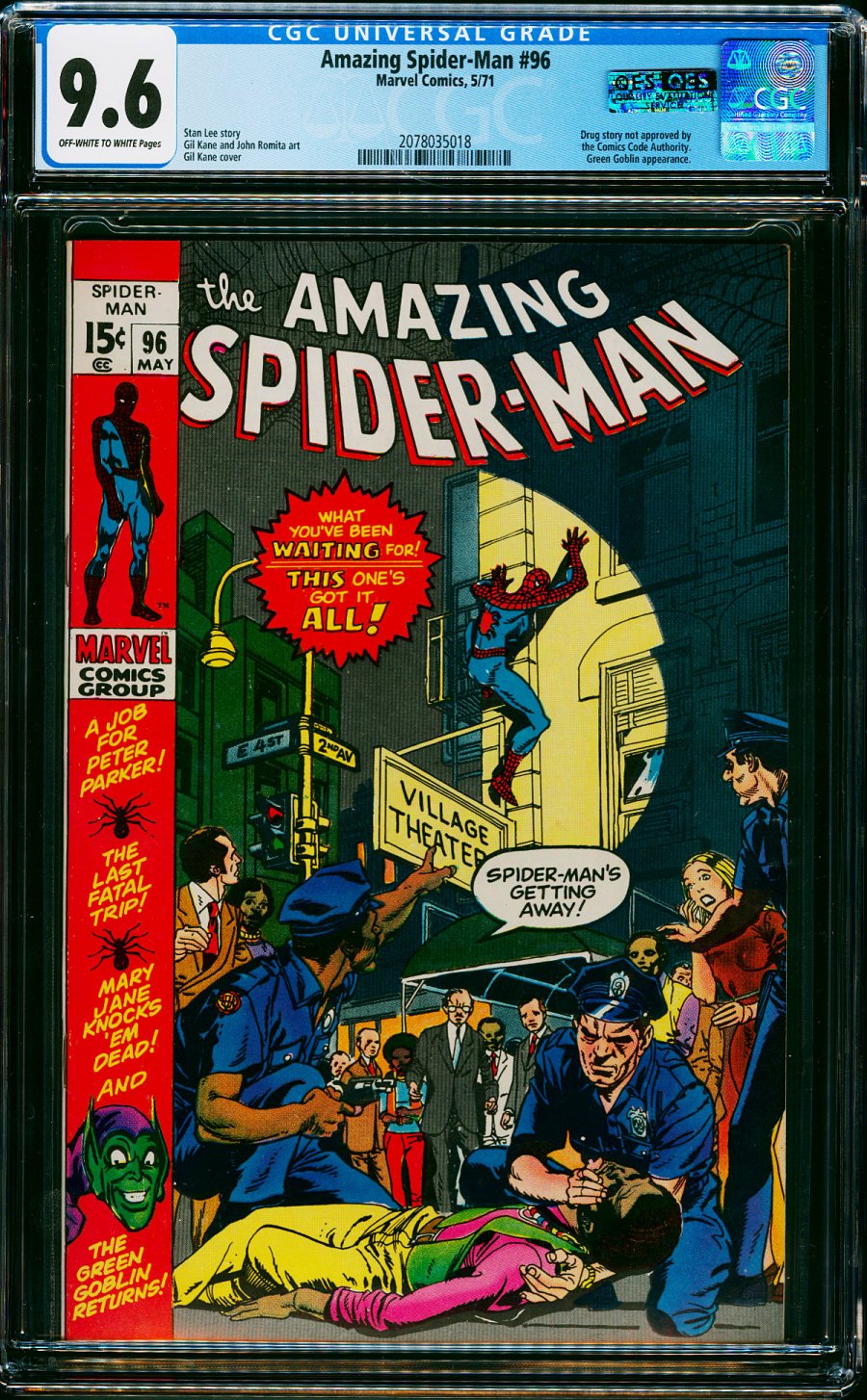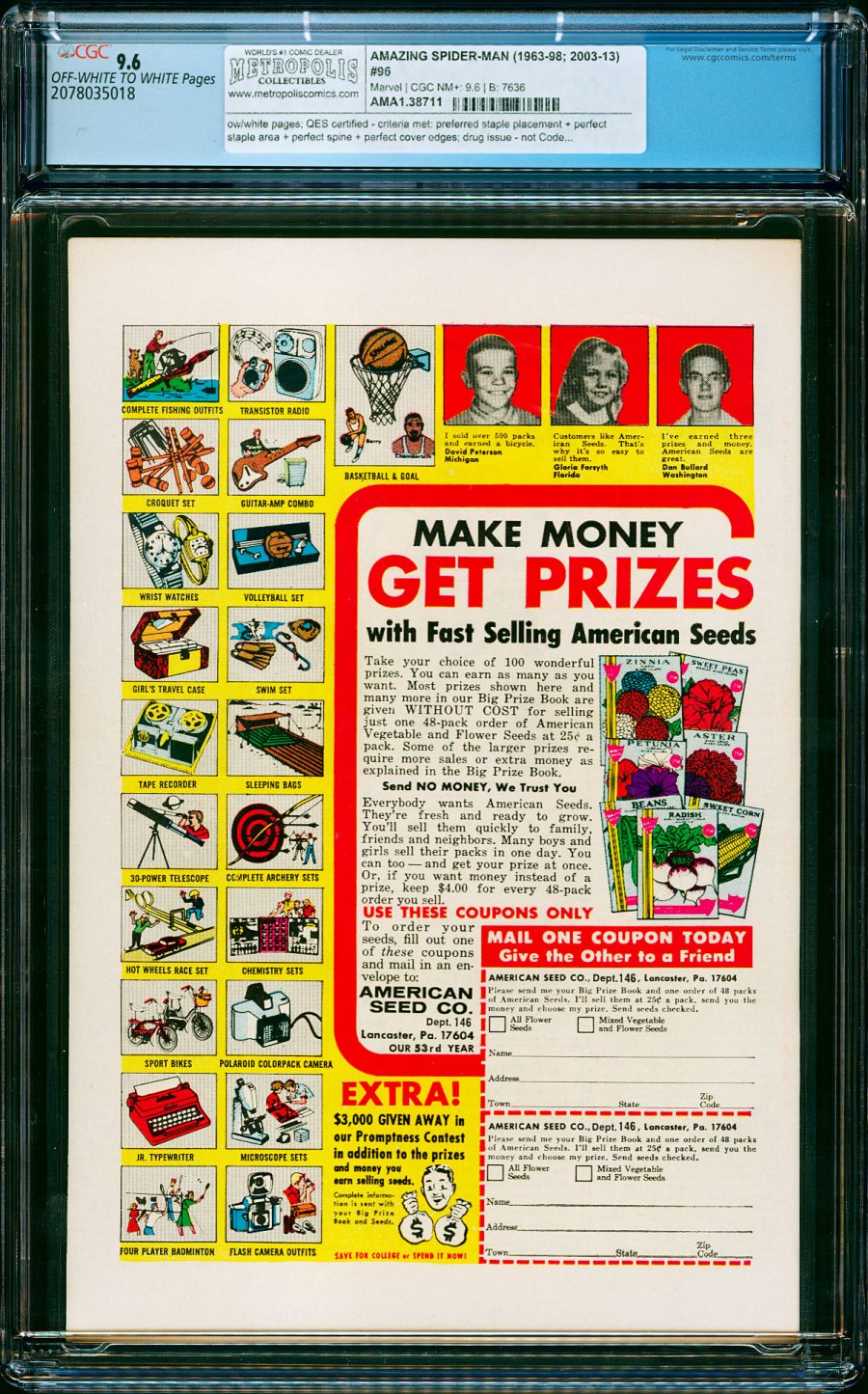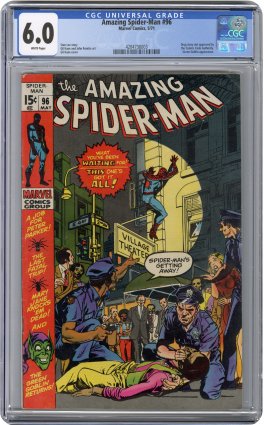AMAZING SPIDER-MAN (1963-98; 2003-13) #96
CGC NM+: 9.6

(Stock Image)

YES
Accepting Offers
--
Offers
PUBLISHER: Marvel
COMMENTS: ow/white pages; QES certified - criteria met: preferred staple placement + perfect staple area + perfect spine + perfect cover edges
1 of 3 comics published without approval of CCA, led to revision of code, leading to a revival of horror/mystery comics and a larger array of topics for stories; Gil Kane/Frank Giacoia cover/art
Read Description ▼
1 of 3 comics published without approval of CCA, led to revision of code, leading to a revival of horror/mystery comics and a larger array of topics for stories; Gil Kane/Frank Giacoia cover/art
DESCRIPTION
ow/white pages; QES certified - criteria met: preferred staple placement + perfect staple area + perfect spine + perfect cover edges
1 of 3 comics published without approval of CCA, led to revision of code, leading to a revival of horror/mystery comics and a larger array of topics for stories; Gil Kane/Frank Giacoia cover/artThis classic issue is the first of three that were not approved by the Comics Code Authority because of the (anti-) drug themed story. (Not that the Comics Code was pro-drug, of course. It's just that back then, comics couldn't mention drugs at all, even negatively.) Stan Lee published the stories anyway, which eventually led to a major revision in the code, allowing for anti-drug stories, plus other various things such as horror comics and vampires. (That's why there were suddenly tons of horror and mystery comics in the early seventies, shortly after the revision went into effect.) Anyway, back to the Spider-Man story at hand: the Green Goblin returns to annoy Spider-Man in "And Now, the Goblin." Script by Stan Lee, pencils by Gil Kane, and inks by Frank Giacoia. Kane cover.
Artist Information
Gil Kane was a Latvian-born American comics artist whose career spanned the 1940s to the 1990s and virtually every major comics company and character. Kane co-created the modern-day versions of the superheroes Green Lantern and the Atom for DC Comics, and co-created Iron Fist with Roy Thomas for Marvel Comics. He was involved in such major storylines as that of The Amazing Spider-Man #96–98, which, at the behest of the U.S. Department of Health, Education, and Welfare, bucked the then-prevalent Comics Code Authority to depict drug abuse, and ultimately spurred an update of the Code. Kane additionally pioneered an early graphic novel prototype, His Name Is... Savage, in 1968, and a seminal graphic novel, Blackmark, in 1971. In 1997, he was inducted into both the Will Eisner Comic Book Hall of Fame and the Harvey Award Jack Kirby Hall of Fame.
1 of 3 comics published without approval of CCA, led to revision of code, leading to a revival of horror/mystery comics and a larger array of topics for stories; Gil Kane/Frank Giacoia cover/artThis classic issue is the first of three that were not approved by the Comics Code Authority because of the (anti-) drug themed story. (Not that the Comics Code was pro-drug, of course. It's just that back then, comics couldn't mention drugs at all, even negatively.) Stan Lee published the stories anyway, which eventually led to a major revision in the code, allowing for anti-drug stories, plus other various things such as horror comics and vampires. (That's why there were suddenly tons of horror and mystery comics in the early seventies, shortly after the revision went into effect.) Anyway, back to the Spider-Man story at hand: the Green Goblin returns to annoy Spider-Man in "And Now, the Goblin." Script by Stan Lee, pencils by Gil Kane, and inks by Frank Giacoia. Kane cover.
Artist Information
Gil Kane was a Latvian-born American comics artist whose career spanned the 1940s to the 1990s and virtually every major comics company and character. Kane co-created the modern-day versions of the superheroes Green Lantern and the Atom for DC Comics, and co-created Iron Fist with Roy Thomas for Marvel Comics. He was involved in such major storylines as that of The Amazing Spider-Man #96–98, which, at the behest of the U.S. Department of Health, Education, and Welfare, bucked the then-prevalent Comics Code Authority to depict drug abuse, and ultimately spurred an update of the Code. Kane additionally pioneered an early graphic novel prototype, His Name Is... Savage, in 1968, and a seminal graphic novel, Blackmark, in 1971. In 1997, he was inducted into both the Will Eisner Comic Book Hall of Fame and the Harvey Award Jack Kirby Hall of Fame.



1 of 3 comics published without approval of CCA, led to revision of code, leading to a revival of horror/mystery comics and a larger array of topics for stories; Gil Kane/Frank Giacoia cover/art
1 of 3 comics published without approval of CCA, led to revision of code, leading to a revival of horror/mystery comics and a larger array of topics for stories; Gil Kane/Frank Giacoia cover/art